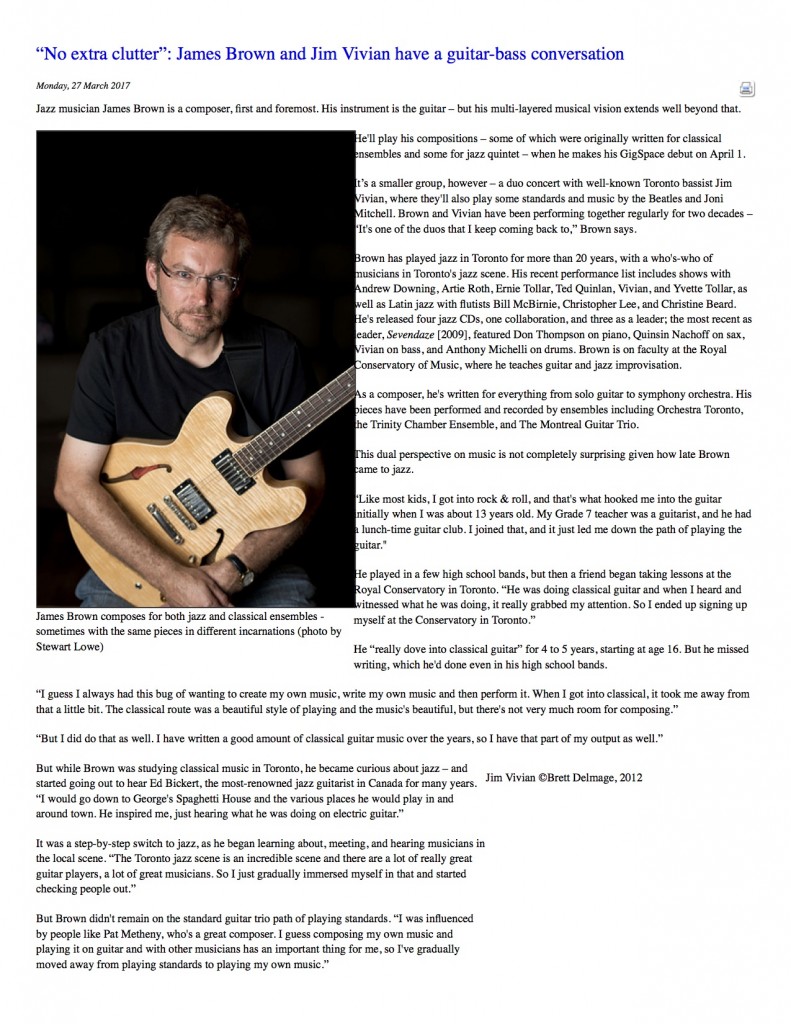Interview with Joe Dimino (Neon Jazz Kansas City)
“This is a stunning album.”
Lauren Hancock, Producer, CBC, Saturday Night Jazz
“This is one of the best jazz guitar albums this writer, who fervently listens to greats like Frisell, Bernstein, and Metheny, has heard in recent memory. It can easily stand with the best from those giants.”
Jim Hynes, Making a Scene
“very fresh and original, great musicianship.”
Michael Philips WOWD-LP Takoma Park 94.3FM
“I love this record”
Brad Stone, Soul and Jazz UK
“Quite enjoyed this album, especially his ultra
subtle rendition of Joni’s ‘A Case of You’ and ‘Mbira Kids”.
Tony Hillier Hillier’s Planet Jazz radio program (89.1 FM Cairns)
“A truly satisfying and fantastic album”.
Kati Kiilaspea The Whole Note Magazine
“James Brown is really fantastic”.
Chris Shaw WOBC-FM Oberlin Ohio
Article by Jim Hynes
Mar 18, 2022 Making a Scene Magazin
James Brown Song Within the Story (NGP)
With the most familiar of names, Canadian jazz guitarist James Brown is likely not familiar to those who are now reading this. Song Within the Story is his first album in more than a decade to boot. It’s primarily a trio recording, featuring bassist Clark Johnston, and drummer Anthony Michelli, with guest tenorist Mike Murley on three tracks. The trio hails from Toronto along with Murley, a top improviser, who has appeared on 14 Juno-winning recordings over the past three decades (seven as a leader or co-leader and seven as a sideman). This is a fusion album, but not of the jazz-rock variety although at times, it bears those qualities. Brown has built his reputation on marrying jazz and classical music, to the point of writing his master’s thesis on the Third Stream movement (the early ‘60s movement to merge the two genres). Some of that inevitably comes across on these eight originals but the music swings too, as Brown’s rhythm mates push him from melodic lines into inventive, often ferocious improvisations with rich, loud, reverberating effects. They also deliver unique interpretations of Canadian folk-rock classics: Neil Young’s “The Needle and the Damage Done” and Joni Mitchell’s “A Case of You.”
The full tone of Brown’s guitar, Johnston’s robust bass, and especially MIchelli’s intricate, driving and remarkably tasteful work on the kit make for sound that sets itself clearly apart from most jazz guitar trios. Although the music is often intricate and complex, the musicians deliver it accessibly with a polished interplay that could only come from frequent gigging over the past three or four years in their home city.
They open with “Igor,” a tribute to one of Brown’s favorite composers, Stravinsky. The backbone of the piece is the bass figure from Soldier’s March in the composer’s “L Histoire du soldat,” which evolves in a blistering minor blues before returning to the heavy, rather daunting theme. “Alystair and I” is a syncopated shuffle in 7/4 time dedicated to Brown’s son. Not only does this offer hints of Bill Frisell’s thoughtful, folk-oriented approach but Michelli’s throbbing, pulsing drumming is simply stunning here.
The major takeaway from the title track is the harmonic effect of Brown’s guitar and Murley’s tenor to create an edgy, contemplative, but disarming feel. Brown reimagined this piece from the opening movement of his chamber work, “The Mosley Street Suite,” originally a vocal setting of the T. S. Eliot poem “The Hollow Men,” thus the tonality. This track is hardly jazz-classical but instead bears more elements of jazz-fusion or even rock with echoes of Pat Metheny. Brown says, “I’ve always liked Pat Metheny and Steve Swallow and that ECM style of writing. I’m not afraid of going into folk or rock. I like when there’s something a little bit more going on.”
“Nice Folk” retreats into more flowing melodic lines, with a lyrical solo spot from bassist Johnston and more impressive skittering kit work from Michelli. The harmonically and rhythmically complex sing-song theme of “The Circle” follows, yet another example of telepathic trio interplay. “Sands of Swing” also brings rhythmic challenges that the trio and the returning Murley deftly navigate as Brown and the saxophonist trade solos and refract off each other in a way that evokes the ECM imprint of Keith Jarrret’s European Quartet. The more delicate “All Rivers Lead” is marked by riveting guitar-sax interplay and Murley’s solo which draws a superb balance between thoughtful exploration and burning intensity. “Mbira’s Kids,” based on rhythmic figures used in sacred Shona music from Zimbabwe, is the most radio friendly of the tunes. It’s the fourth and concluding movement from “The Mosley Street Suite” and has Brown in a spiritual mode with his spiraling, distortion-laden solo
| The two covers honor the two most notable Canadian artists of the folk-rock era, Neil Young and Joni Mitchell. These imaginative interpretations first render Young’s “The Needle and the Damage Done” into dirge-like, deeply solemn territory beyond that envisioned by the original composer, later spiked by blistering axe work. On the other hand, they take Mitchell’s “A Case of You” more faithfully with Johnston introducing the melody on the bass. The tune serves as a nice album closer, like the after-dinner cordial that just puts the cap on a flavorful meal. |
This is one of the best jazz guitar albums this writer, who fervently listens to greats like Frisell, Bernstein, and Metheny, has heard in recent memory. It can easily stand with the best from those giants.
- Jim Hynes Making a Scene Magazine

Sevendaze
“Music that makes you sit up and take notice”
Jazz FM 91.1 (Toronto)
“ a dedicated and impeccably beautiful musician as well a composer of truly fascinating music. He is an excellent jazz player and his vast experience in classical music enables him to write music on a level beyond what most of us can do”.
Don Thompson (OC)
“Excellent, a classy 16-tune collection of originals….that’s full of smartly ’executed ideas”
The Toronto Star
“…James Brown is exploratory, inventive with a natural fluency and a ton of endless, intriguing ideas.”
Performing Arts magazine
“one of the foremost contributors to the developing guitar repertoire in Canada.”
Jeffery McFadden (University of Toronto)
“…Alternating melody, comping and soloing, both (james) Brown and (Don) Thompson demonstrated musical intuition, facility and chemistry found only among the most talented of jazz performers. Their improvisational ideas were well-conceived and purposefully delivered, without superfluous notes or flashy show.”
The Waterloo Record
“You are a man full of powers, with a lot of Inspiration and quite a gift for composing”
Angelo Gilardino (Italy)
Review of Sevendaze written by Sharna Searle for “Whole Note Magazine” 10/03/11
The Whole Note Review of Sevendaze
He may not be “The Godfather of Soul” but this James Brown– “our” raised-in- Burlington-now-residing-in-Toronto James Brown – brings much soul, sophistication, style and serious skill to his latest CD.
Currently teaching guitar and jazz improvisation at the Royal Conservatory in Toronto, Brown has produced a vibrant and inventive CD of nine original compositions. Joining him on this splendid album are some of Canada’s finest: Quinsin Nachoffon tenor and soprano saxophone (see GeoffChapman’sexcellent review of his latest offering in last month’s WholeNote online at www.thewholenote.com); the always great Don Thompson on piano; in-demand bassist Jim Vivian; and the widely respected Anthony Michelli on drums. A stellar local line-up!
Brown is known for his lyrical tone, fluid, melodic lines and elegant writing and he doesn’t disappoint here. As well, his classical training is evident and it is not surprising to learn that he is an associate composer of the Canadian Music Centre.
The classical influence is most apparent in Fugue, where he weaves a beautiful exchange of fugal voices between the guitar and saxophone, joined in a third voice by the bass. The playing (as well as the writing) is languid and expressive.Oddly, I found the title track, spelled Sevendays, to be the least interesting, although still enjoyable. It is expansive and breezy,reminiscent, at times, of early Metheny.
Perhaps Brown is at his most soulful in Central Eastern (part 1), an evocative, melancholic and lyrical preamble to Central Eastern (part 2), which, in contrast, is driving, exhilarating and had me at the edge of my seat. It really swings with its subtle, not so much central but more Middle Eastern, flavour. Thompson provides some gorgeous piano work and the drumming is especially tasteful.
There’s a reason Brown has the reputation he does as a versatile and talented composer and guitarist.
Actually, he’s given us nine with “Sevendaze”.
